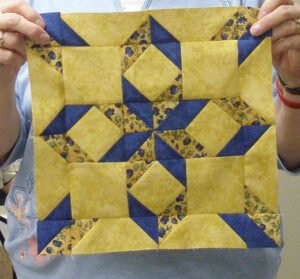The West Virginia Star Block is a beautiful and versatile quilt pattern that brings a touch of elegance and tradition to any quilting project.
With its intricate star shape, this block can stand alone or be paired with other designs for a quilt filled with charm and sophistication.
In this tutorial, we’ll walk you through the process of creating your own West Virginia Star Block, providing fabric measurements, cutting instructions, and step-by-step assembly tips.

Materials Needed for the West Virginia Star Block
Having the right materials is essential for any quilt project, especially when creating a detailed block like the West Virginia Star. You’ll need specific fabrics, basic quilting tools, and patience to bring out the beauty of this star pattern.
Firstly, choose two to three contrasting fabrics to create a visually appealing star pattern. Most quilters prefer a dark fabric for the star points and lighter or medium-toned fabrics for the background. For this tutorial, we’ll assume you’re using two contrasting fabrics: Fabric A for the star points and Fabric B for the background.
You’ll also need basic quilting tools: a rotary cutter, a quilting ruler, a cutting mat, and an iron. Precise cutting and pressing are essential to create a clean, crisp design that will enhance the quilt patterns. Additionally, sewing machine essentials, like quality cotton thread and a quarter-inch foot, will ensure perfect seams and help with the overall accuracy.
Cutting Instructions for the West Virginia Star Block
To create a 12-inch finished West Virginia Star Block, accurate fabric cutting is crucial. Below is a guide on how to cut the fabric pieces you’ll need, along with their measurements.
For Fabric A (Star Points), cut four 4 1/2-inch squares. These will be used to form the points of the star. Ensure you cut them as accurately as possible to avoid issues when piecing the block together.
From Fabric B (Background), cut one 6 1/2-inch square for the center, four 4 1/2-inch squares, and four 3 1/2-inch squares. The background pieces help define the star, creating contrast and visual interest that highlight the design. Each square plays a role in framing the star and completing the block’s layout.
Lay out all cut pieces before sewing to visualize how each component will fit together. Double-check the measurements of each square and trim if necessary, as this will make the assembly process smoother and ensure your final block has crisp, clean lines.
Arranging the West Virginia Star Block Layout
Arranging your quilt pieces before sewing is a vital step in achieving the desired pattern. For the West Virginia Star Block, you’ll need to arrange the center square, star points, and background squares into a grid.
Begin by placing the 6 1/2-inch square of Fabric B in the center. Next, place one 4 1/2-inch square of Fabric A on each side of the center square, positioning them to form the points of the star. This layout forms the star pattern that the block is known for.
Position the remaining 4 1/2-inch and 3 1/2-inch Fabric B squares around the star points to complete the grid layout. This setup will give you a clear vision of how the final block should look once sewn. Taking the time to arrange your pieces beforehand ensures your design is balanced and allows you to make any adjustments before stitching.
Sewing the Star Points: Half Square Triangles
The star points in the West Virginia Star Block are made using half-square triangles (HSTs), which are foundational in many quilt patterns. Creating these HSTs accurately will ensure your star is symmetrical and visually pleasing.
To make the HSTs, take the 4 1/2-inch Fabric A and Fabric B squares. Place one Fabric A square on top of a Fabric B square, right sides facing each other. Draw a diagonal line across the back of one square, then sew a quarter-inch seam on each side of the drawn line.
After sewing, cut along the diagonal line to separate the two halves, then press each HST open with seams pressed toward the darker fabric. You’ll now have two HSTs. Repeat this process with the remaining 4 1/2-inch squares to create the eight star points needed for the block.
Assembling the West Virginia Star Block
With all your HSTs and background squares ready, it’s time to start assembling the block. Lay out the pieces again to ensure everything is in its correct position, then begin piecing each row.
Start by sewing the squares in the first row, carefully matching seams as you go. Use a quarter-inch seam allowance to maintain consistency throughout the block. Repeat the process with the middle and bottom rows, ensuring each row is aligned with the others for a seamless design.
Once you’ve sewn each row, press the seams in alternating directions to reduce bulk. Finally, sew the rows together, pressing the final seams open or to one side as preferred. Your West Virginia Star Block should now be complete, displaying the intricate star pattern with well-aligned points and crisp edges.
Finishing Touches and Tips for Success
To finish your block, give it a final press to smooth out any wrinkles and ensure that all seams lie flat. This final pressing enhances the block’s appearance and makes it ready for incorporation into your quilt.
Check the dimensions of the block to ensure it measures 12 1/2 inches square (including seam allowance). Trim any uneven edges if necessary, being careful not to cut into the seam allowance to maintain the block’s integrity.
Creating a successful West Virginia Star Block relies on precision, patience, and attention to detail. Take your time with each step, especially when aligning seams, to ensure a polished and professional look that will elevate any quilt project.
Ideas for Using the West Virginia Star Block in Quilts
The West Virginia Star Block is a versatile design that works well in various quilt projects. Whether you’re creating a single-block wall hanging or a multi-block quilt, this star pattern adds a striking focal point to any quilt layout.
For a traditional quilt, try pairing the West Virginia Star Block with simple sashing and borders in complementary colors. This setting highlights the star design while allowing it to stand out against the quilt background. Choose sashing that complements the star colors for a cohesive look.
If you prefer a modern twist, alternate the West Virginia Star Block with solid blocks or other star designs. This approach gives your quilt a fresh and dynamic layout, making it perfect for contemporary spaces. The flexibility of this block makes it suitable for various color schemes and quilt styles.
Color Variations and Customization Tips
One of the best aspects of the West Virginia Star Block is the potential for color customization. This block shines in both traditional and modern color schemes, so feel free to experiment with different fabric choices.
For a classic look, use rich jewel tones like navy, burgundy, or emerald paired with neutral backgrounds. This color combination gives the block a timeless appeal that works beautifully in traditional quilts. Adding a small print to the background fabric can also add visual interest without overwhelming the star design.
For a more modern look, consider high-contrast colors like black and white or bold brights against a neutral background. Modern color choices make the West Virginia Star Block feel contemporary, ideal for quilts that need a touch of sophistication. Personalizing your block with unique colors makes it easy to tailor the design to your taste.
Tips for Beginners Creating the West Virginia Star Block
If you’re new to quilting, the West Virginia Star Block may seem complex, but it’s an achievable pattern with a bit of practice and patience. Start by practicing half-square triangles on scrap fabric to become familiar with the process.
Take your time with cutting and sewing, as precision makes all the difference. Use a quarter-inch foot on your sewing machine to keep your seams consistent, and press each seam as you go to create a clean and professional-looking block.
Remember, quilting is a skill that improves with practice. Don’t worry if your first attempt isn’t perfect; each block you make will teach you more about quilting techniques and bring you closer to creating beautiful quilts with this classic star pattern.

